| Revision as of 15:11, 31 March 2023 edit190.57.43.114 (talk) Correcting the use of viejo and antiguoTags: Mobile edit Mobile web edit← Previous edit |
Revision as of 14:18, 11 May 2023 edit undoAmiDaniel (talk | contribs)Extended confirmed users15,065 editsm →History: cite neededNext edit → |
| Line 60: |
Line 60: |
|
|
|
|
|
==History== |
|
==History== |
|
Panama City was founded on August 15, 1519 and it lasted one hundred and fifty-two years. In January 1671, the Governor Juan Perez de Guzman had it set on fire, before the attack and looting by the pirate ]. In 1672, Antonio Fernández de Córdoba initiated the construction of a new city, which was then founded on January 21, 1673. This city was built on a peninsula completely isolated by the sea and a defensive system of walls.<ref name=CASTILLERO>{{cite book|last1=Castillero|first1=Alfredo|title=UNESCO Guides: Panamá la Vieja and Casco Viejo|year=2004|publisher=UNESCO Publishing|isbn=92-3-103923-7}}</ref> Today this place preserves the first institutions and buildings of the modern city of Panama. It is known as ''Casco Viejo'' (Spanish for Old Town). |
|
Panama City was founded on August 15, 1519 and it lasted one hundred and fifty-two years. In January 1671, the Governor Juan Perez de Guzman had it set on fire,{{fact}} before the attack and looting by the pirate ]. In 1672, Antonio Fernández de Córdoba initiated the construction of a new city, which was then founded on January 21, 1673. This city was built on a peninsula completely isolated by the sea and a defensive system of walls.<ref name=CASTILLERO>{{cite book|last1=Castillero|first1=Alfredo|title=UNESCO Guides: Panamá la Vieja and Casco Viejo|year=2004|publisher=UNESCO Publishing|isbn=92-3-103923-7}}</ref> Today this place preserves the first institutions and buildings of the modern city of Panama. It is known as ''Casco Viejo'' (Spanish for Old Town). |
|
|
|
|
|
In recent years, Casco Viejo— through gentrification— has become a tourist hotspot filled with restaurants, boutique hotels, and nightclubs; while also maintaining the multiple historical sites it has to offer.<ref>{{Cite web|title=The Gentrification of Casco Viejo, Panama – Salt Trails|url=http://salttrails.com/the-gentrification-of-casco-viejo-panama/|access-date=2021-03-04|website=salttrails.com}}</ref><ref>{{Cite web|last=Gold|first=David|title=Nightlife in Casco Viejo|url=https://cascospanish.com/nightlife-in-casco-viejo/|access-date=2021-03-04|website=Casco Antiguo Spanish School|language=en-US}}</ref> |
|
In recent years, Casco Viejo— through gentrification— has become a tourist hotspot filled with restaurants, boutique hotels, and nightclubs; while also maintaining the multiple historical sites it has to offer.<ref>{{Cite web|title=The Gentrification of Casco Viejo, Panama – Salt Trails|url=http://salttrails.com/the-gentrification-of-casco-viejo-panama/|access-date=2021-03-04|website=salttrails.com}}</ref><ref>{{Cite web|last=Gold|first=David|title=Nightlife in Casco Viejo|url=https://cascospanish.com/nightlife-in-casco-viejo/|access-date=2021-03-04|website=Casco Antiguo Spanish School|language=en-US}}</ref> |
Panama City was founded on August 15, 1519 and it lasted one hundred and fifty-two years. In January 1671, the Governor Juan Perez de Guzman had it set on fire, before the attack and looting by the pirate Henry Morgan. In 1672, Antonio Fernández de Córdoba initiated the construction of a new city, which was then founded on January 21, 1673. This city was built on a peninsula completely isolated by the sea and a defensive system of walls. Today this place preserves the first institutions and buildings of the modern city of Panama. It is known as Casco Viejo (Spanish for Old Town).
In recent years, Casco Viejo— through gentrification— has become a tourist hotspot filled with restaurants, boutique hotels, and nightclubs; while also maintaining the multiple historical sites it has to offer.
 Aerial Panorama (Casco Antiguo)
Aerial Panorama (Casco Antiguo) Location of San Felipe(Casco Antiguo) in Panamá province
Location of San Felipe(Casco Antiguo) in Panamá province
 Panama Canal Museum
Panama Canal Museum
Plaza de la Independencia
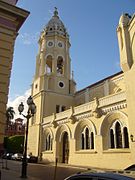 San Francisco de Asís Church
San Francisco de Asís Church
 Inside San Francisco de Asís Church
Inside San Francisco de Asís Church
 National Theater
National Theater
 Inside the National Theater
Inside the National Theater
 Society of Jesus
Society of Jesus
 Convento de Santo Domingo
Convento de Santo Domingo
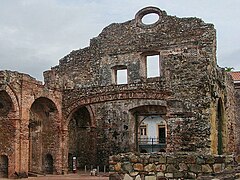 Arco Chato
Arco Chato
 San José Church
San José Church
 Typical houses
Typical houses
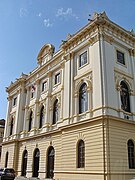 Palacio Nacional
Palacio Nacional
 Palacio de las Garzas
Palacio de las Garzas
Casa Góngora
 Catedral Metropolitana
Catedral Metropolitana
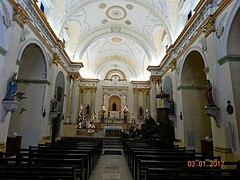 Inside the Catedral Metropolitana
Inside the Catedral Metropolitana
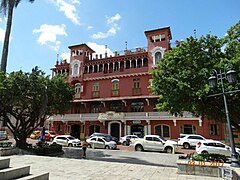 Plaza Bolivar
Plaza Bolivar
 Map of Panama and its suburb in 1789
Map of Panama and its suburb in 1789
Plaza Herrera
 Panama City view from Casco Viejo
Panama City view from Casco Viejo
 (in Spanish)
(in Spanish)